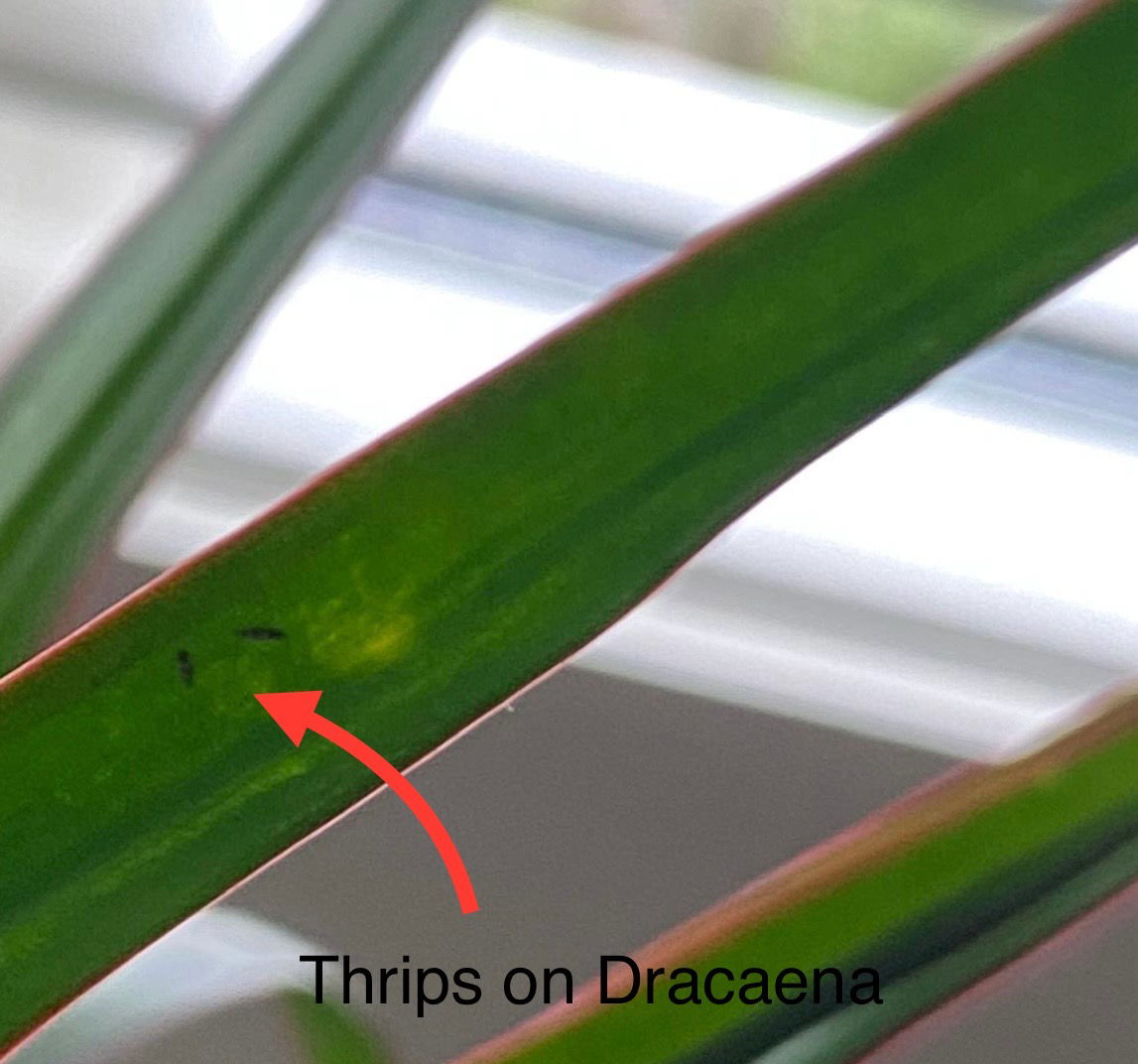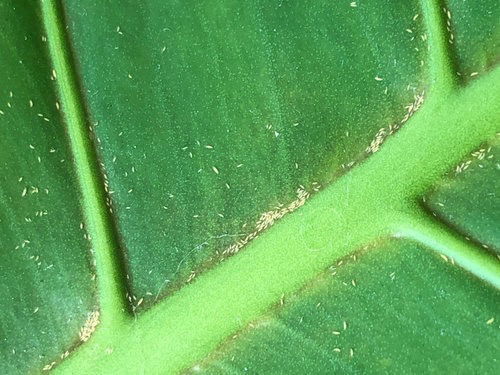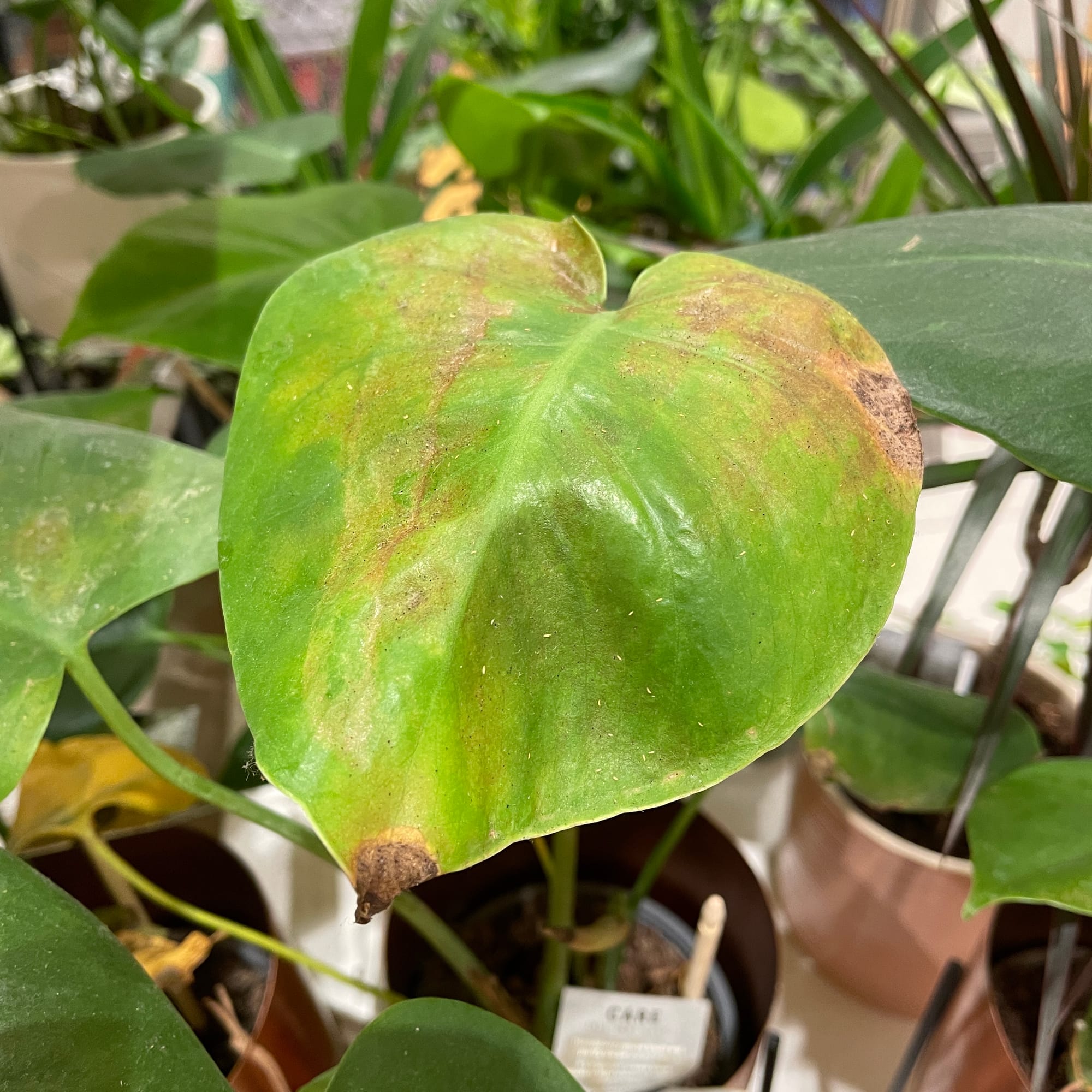Tetranychus urticae
Contents
- Information
- Top Tips & Info
- Symptoms
- Susceptible Plants & Parts
- Actions Needed (Includes pros & cons of Chemical or Organic based pesticides)
- Ways to Prevent an Attack in the Future
Need the answer to a specific plant or pest query? Book a 1-to-1 video call with THE HOUSEPLANT DOCTOR™, the website's friendly author, to overcome and address your niggling problem! Available on iMessage, WhatsApp, Facebook Messenger & more.
Introduction
Thrips are small, tubular-shaped flies that'll bring great destruction to the unfortunate plant(s). They can be introduced into the home via many different methods, but most notably being through an open window, newly-bought plant or via infected soil during transplantation. Despite their damaging destruction, they can be easily eradicated using the correct methods which will be discussed below.
Top Tips & Info
- Eradication Difficulty - Easy (compared to removing other houseplant pests)
- Life Cycle - Up to forty days.
- The female can lay up to two-hundred eggs in total.
- Thrips will prance along the plant's flat surfaces, meaning that pretty much all parts above the soil line can be affected.
- Remove and crush each visible bug and larvae using your fingers or a damp cloth.
- Prune off the worst affected leaves and any flowers that house the infestation.
- Take the plant outside and perform a gentle hose-down. Aim at all of the cubbyholes and leaves for complete obliteration.
- Replace the top quarter of the soil with a fresh best of the appropriate compost while it's drying off.
- Once dry, spray the foliage using either an organic or chemical-based pesticide. A good organic product would be Andermatt's Thrip Killer that uses nature to eradicate this pest.
- Repeat the wiping, hosing-down and pesticide steps every 7 - 14 days, until there are no signs of an infestation for several weeks.
- It's mandatory to quarantine the affected specimens into another room to avoid further spread during an attack.
What are the Symptoms of Thrips on Houseplants?
You'll first notice the yellow, egg-like larvae appearing on the top sides of the foliage. After a few seconds of inspection, minuscule black and white flies will be parading over the whole plant, including the soil, stem and flowers. Yellow, dark patches will quickly develop within the next few days once an infestation takes over. Thrips can be a very damaging pest as they'll scrape the cell membranes off from the leaf - action must be taken immediately for the prevention of death.
Before we go into the remedies for addressing this pest, have a quick look at the neighbouring plants to see if they've become under attack, too. Thrips are very 'contagious', so the likelihood of multiple specimens sharing the infestation is pretty high.
Houseplants that are rarely misted are also more likely to be affected by Thrips as the pests don't like getting wet. When the leaves are misted (or soaked by the rain or shower), this can dislodge the Thrip and even cause them to drown in some cases.
What does a Thrip look like? This is an adult Thrip pictured on a Dracaena marginata that'll measure around 1-2mm in length.
What are the yellow maggot/larvae shaped bugs on my houseplants? This is exactly what the larvae of a Thrip will look like on leaves, which travel a little slower than the black adults but can cause the same level of damage in a short time frame.
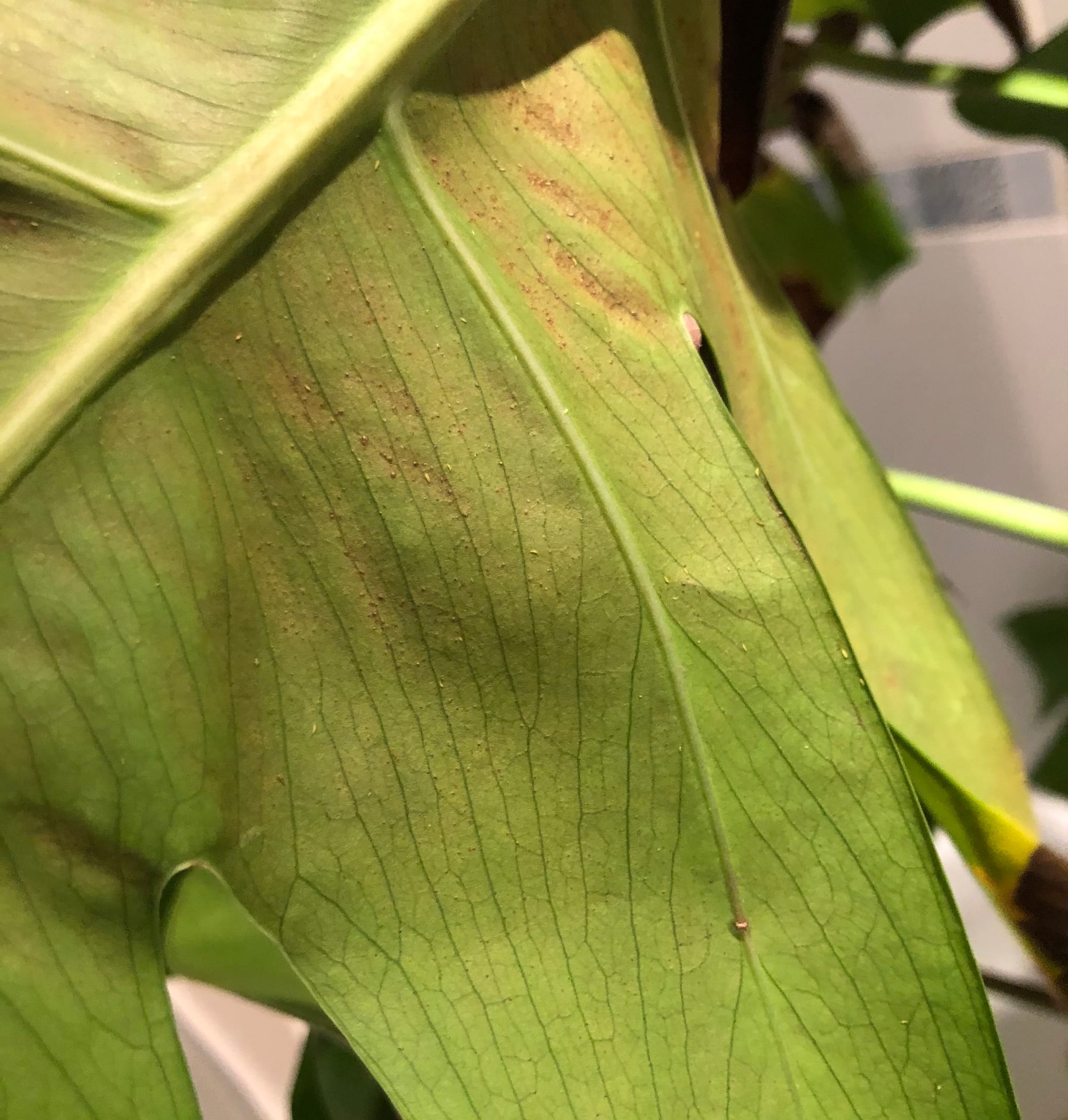
Here is an example of what Thrip damage looks like on a houseplant. Monstera deliciosa (Cheese Plants) is the most common indoor plant to be attacked by Thrips in the northern hemisphere.
The damage on newly unfurled leaves can be more substantial compared to already-mature leaves. Here is a newly produced Monstera leaf that will have to be cut off.
What are the most Susceptible Houseplants & Where do Thrips live on them?
Both sides of the leaves, but mostly on the top-side. They tend to attack middle-aged growth and will quickly destroy new growth if exposed.
Plants - Most houseplants are at risk of an infestation; however, some families, like the Cactaceæ (Desert & Jungle Cacti) and succulents, are exempt from an attack. The most common plants to be engulfed with Thrips are Palms, Dracaena (Dragon Trees) and members of the Aroid family (Alocasia, Chinese Evergreens, Dieffenbachia, Monstera, Peace Lilies, ZZ Plants). Thrips generally like broad, thin leaves that can host large numbers of eggs and nutritional sap.
What are the Actions Required to Eradicate Thrips from Houseplants?
1. While using a damp cloth, destroy as many bugs and their larvae as possible. Any flowers must be removed along with the worst affected leaves or stems.
2. Take the plant outside and GENTLY wash the stem, leaves and each cubbyhole using an outdoor hose. It's important to spray in at least three different angles towards the specimen to ensure thorough administration.
3. While the plant is drying-off, remove the top quarter of the soil in favour of a fresh batch of the appropriate product - ‘Cactus & Succulent’ compost for arid-dwelling species, tropical plants for ‘Houseplant’ labelled potting mixes, etc. It's vital to replace the soil, as once summer arrives, any burrowed larvae may hatch and continue to wreak havoc on the hosting plant.
4. Perform a final hose-down before placing it in a warm room, away from other specimens to dry-off. If the temperature is above 15℃ (59℉), keep it outside so that natural predators, (like ladybirds and green lacewings) can have a go at the critters.
5. Once the specimen is bone-dry, it's time to use a pesticide. You can choose either an organic or chemical-based product, but always make sure that the pesticide is qualified to be used against pests.
6. Keep the affected plant away from others in a quarantined room until the symptoms have subsided for at least four weeks. Always be wary of a relapse, and keep an eye out for possible outbreaks for several months after the last sighting.
Organic Pesticides
Natural Predators - Using predatory mites to eradicate Thrips is the most natural, least time consuming way that won't use any harsh chemicals on the leaves. THE HOUSEPLANT DOCTOR™ recommends using Andermatt's Thrip Killer, which is a product packed with predatory mites (Amblyseius andersoni) that'll get to work within a few hours of application. Click here to view their product & get 15% off with our code 'JOE15'.
Note: It's good to remember that 'Spinosads' are usually only sold to professional sellers and should be avoided for hobbyists.
Chemical Pesticides
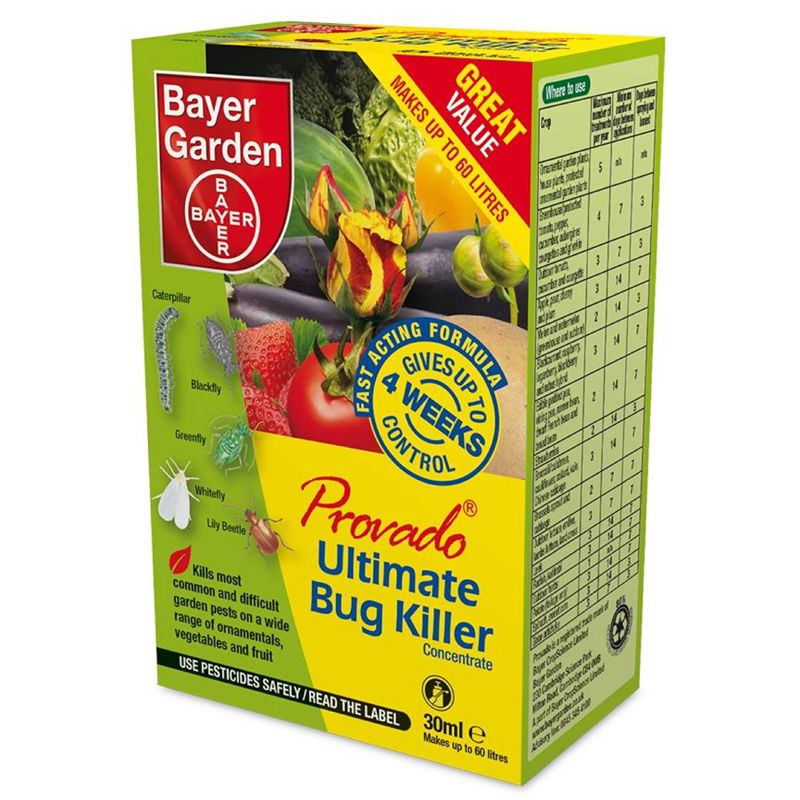
Provanto - 'Bayer Garden Provado Ultimate Fruit and Vegetable Bug Killer Concentrate' works IMMEDIATELY after one application. It's a concentrated product, meaning that you'll have to dilute it with the appropriate amount of water. Spray both sides of the leaves, along with any cubbyholes that could house the infestation. Keep the plant away from other specimens once there are no signs of an outbreak for over a month. Chemical-based pesticides should only be used as a last-resort measure due to the risk of affecting other biodiversity.
Rubbing Alcohol - If you're looking for something with even more strength, try an Isopropyl Rubbing Alcohol, which can be bought from many online stores. This pesticide will work immediately, killing the bugs within a few hours of contact. Follow the manufacturer's recommendations and repeat hosing the plant down and pesticide application steps fortnightly until the infestation has elapsed. Keep it well away from others until the plant is deemed safe.
Ways to Prevent an Attack in the Future
1. When buying a new plant from a local plant shop or garden centre, check around the common areas for infestations like its leaves, stems and flowers. Most Thrip issues come from already-affected plants, so always keep this in mind when increasing your plant-collection!
2. Keep the windows shut during the Summer when Thrips are most active, or set up a magnetic window mesh/netting like these to stop them coming indoors.
3. Change the top layer of the soil when bringing any new plant from a shop. Replacing the top layer of the compost will remove any larvae that may have fallen in, or been deposited by a pest. THE HOUSEPLANT DOCTOR™ does this religiously whenever a new plant enters the house!
4. Perform monthly checks for pests on your own plants. Although this may sound patronising, many gardeners forget to inspect their indoor specimens and that's exactly when an infestation can arise.
Book a 1-to-1 Consultation with THE HOUSEPLANT DOCTOR™
Need realtime advice for your Thrip infestation? Book a video or message consultation with expert Joe Bagley, THE HOUSEPLANT DOCTOR™ (author or ukhouseplants.com). Choose between a ten or thirty-minute session & a platform of your choice (WhatsApp, FaceTime, Facebook Messenger or Zoom). Ask unlimited questions in one session, including queries on your dying/challenging plants, pests eradication, terrariums, repotting advice & everything in between! Available worldwide.
